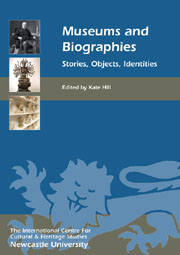Book contents
- Frontmatter
- Contents
- List of Illustrations
- Introduction: Museums and Biographies – Telling Stories about People, Things and Relationships
- INDIVIDUAL BIOGRAPHY AND MUSEUM HISTORY
- PROBLEMATISING INDIVIDUALS' BIOGRAPHIES
- INSTITUTIONAL BIOGRAPHIES
- OBJECT BIOGRAPHIES
- MUSEUMS AS BIOGRAPHY
- 16 Houses and Things: Literary House Museums as Collective Biography
- 17 ‘Keepers of the Flame’: Biography, Science and Personality in the Museum
- 18 National History as Biography: Alexandre Lenoir's Museum of French Monuments
- MUSEUMS AS AUTOBIOGRAPHY
- Endpiece: The Homunculus and the Pantograph, or Narcissus at the Met
- List of Contributors
- Index
18 - National History as Biography: Alexandre Lenoir's Museum of French Monuments
from MUSEUMS AS BIOGRAPHY
Published online by Cambridge University Press: 05 February 2013
- Frontmatter
- Contents
- List of Illustrations
- Introduction: Museums and Biographies – Telling Stories about People, Things and Relationships
- INDIVIDUAL BIOGRAPHY AND MUSEUM HISTORY
- PROBLEMATISING INDIVIDUALS' BIOGRAPHIES
- INSTITUTIONAL BIOGRAPHIES
- OBJECT BIOGRAPHIES
- MUSEUMS AS BIOGRAPHY
- 16 Houses and Things: Literary House Museums as Collective Biography
- 17 ‘Keepers of the Flame’: Biography, Science and Personality in the Museum
- 18 National History as Biography: Alexandre Lenoir's Museum of French Monuments
- MUSEUMS AS AUTOBIOGRAPHY
- Endpiece: The Homunculus and the Pantograph, or Narcissus at the Met
- List of Contributors
- Index
Summary
Alexandre Lenoir's Museum of French Monuments in Paris (1795–1816) began life as a temporary depot during the French Revolution, sheltering artefacts salvaged from nationalised church, royal and aristocratic property. Following Lenoir's dogged pursuit of his cause, the depot was eventually turned into a public museum that fused emerging ideas about art, history and personality, enhanced with the flair of Lenoir's creative curation, to produce a unique representation of France. Unlike the model of the great museums, which was developing nearby in the high-profile Louvre and was to become the norm in the 19th century, the Museum of Monuments presented an alternative way of engaging with art and history, investing in imagination, allegory and empathy rather than abstracted rational principles. In that sense, despite its provenance and nationalist rhetoric, Lenoir's project has greater affinity with the idiosyncratic personal collections of the 18th and 19th centuries, rather than the public institutions that came to define the modern museum (Fig 18.1).
The largest of the Revolutionary depots in Paris was the convent of the Petits-Augustins on the left bank, whose keeper, appointed in 1791, was Alexandre Lenoir, a former student of the painter Doyen. Lenoir immediately embraced his task as guardian of the depot with zeal beyond the requirements of his job, which involved mainly the recording and labelling of objects. He would accompany the Commission of Monuments on its daily surveys of churches and attempt to exert some influence in order to steer pieces that interested him to the Petits-Augustins.
- Type
- Chapter
- Information
- Museums and BiographiesStories, Objects, Identities, pp. 265 - 276Publisher: Boydell & BrewerPrint publication year: 2012



